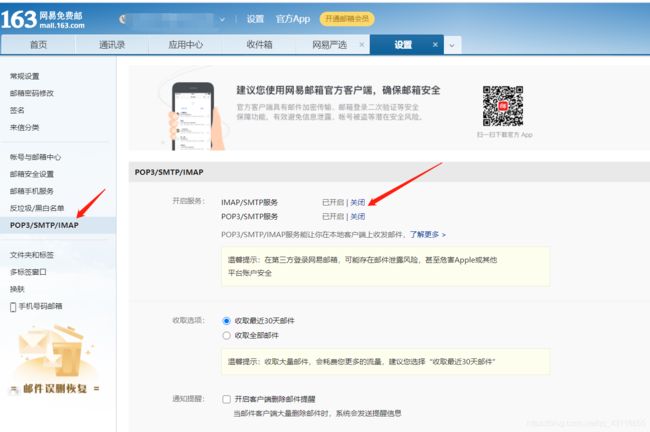实战总结:邮箱发送验证码
java邮箱发送验证码
目前项目中需要同时支持短信和邮箱验证,短信用的是腾讯云就不多说了,在此分享一下邮箱验证码发送。
首先,作为发送邮箱,需要开启POP3/SMTP/IMAP,登录邮箱–设置–账户–开启POP3/SMTP/IMAP,开启时可能会有短信验证,开启后显示验证码之类的一串英文,复制保存起来,后面要用

开启之后就可以作为发送邮箱,发验证码给用户了,代码如下
pom包引入:
<dependency>
<groupId>com.sun.mailgroupId>
<artifactId>javax.mailartifactId>
<version>1.6.2version>
dependency>
邮箱发送工具类:
package com.es.biz.common.utils;
import com.sun.mail.util.MailSSLSocketFactory;
import javax.mail.Message;
import javax.mail.Session;
import javax.mail.Transport;
import javax.mail.internet.InternetAddress;
import javax.mail.internet.MimeMessage;
import java.util.Properties;
/**
* 邮箱发送工具类
*/
public class MailUtils {
public static void main(String[] args) {
sendMail("邮件接收者");
}
/**
* 发送验证码
*
* @param receiveMail
* @throws Exception
*/
public static void sendMail(String receiveMail) {
Properties prop = new Properties();
// 开启debug调试,以便在控制台查看
prop.setProperty("mail.debug", "true");
// 设置邮件服务器主机名
prop.setProperty("mail.host", "smtp.163.com");
// 发送服务器需要身份验证
prop.setProperty("mail.smtp.auth", "true");
// 发送邮件协议名称
prop.setProperty("mail.transport.protocol", "smtp");
// 开启SSL加密,否则会失败
try {
MailSSLSocketFactory sf = new MailSSLSocketFactory();
sf.setTrustAllHosts(true);
prop.put("mail.smtp.ssl.enable", "true");
prop.put("mail.smtp.ssl.socketFactory", sf);
// 创建session
Session session = Session.getInstance(prop);
// 通过session得到transport对象
Transport ts = session.getTransport();
// 连接邮件服务器:邮箱类型,帐号,POP3/SMTP协议授权码 163使用:smtp.163.com,qq使用:smtp.qq.com
ts.connect("smtp.163.com", "邮件发出者", "上面保存的验证码(一串英文)");
// 创建邮件
Message message = createSimpleMail(session, receiveMail);
// 发送邮件
ts.sendMessage(message, message.getAllRecipients());
ts.close();
} catch (Exception e) {
e.printStackTrace();
}
}
/**
* @Method: createSimpleMail
* @Description: 创建一封只包含文本的邮件
*/
public static MimeMessage createSimpleMail(Session session, String receiveMail) throws Exception {
// 获取6位随机验证码(英文)
String[] letters = new String[]{
"q", "w", "e", "r", "t", "y", "u", "i", "o", "p", "a", "s", "d", "f", "g", "h", "j", "k", "l", "z", "x", "c", "v", "b", "n", "m",
"A", "W", "E", "R", "T", "Y", "U", "I", "O", "P", "A", "S", "D", "F", "G", "H", "J", "K", "L", "Z", "X", "C", "V", "B", "N", "M",
"0", "1", "2", "3", "4", "5", "6", "7", "8", "9"};
StringBuilder stringBuilder = new StringBuilder();
for (int i = 0; i < 6; i++) {
stringBuilder.append(letters[(int) Math.floor(Math.random() * letters.length)]);
}
//获取6位随机验证码(中文),根据项目需要选择中英文
String verifyCode = String.valueOf(new Random().nextInt(899999) + 100000);
// 创建邮件对象
MimeMessage message = new MimeMessage(session);
// 指明邮件的发件人
message.setFrom(new InternetAddress("邮件发出者"));
// 指明邮件的收件人,现在发件人和收件人是一样的,那就是自己给自己发
message.setRecipient(Message.RecipientType.TO, new InternetAddress(receiveMail));
// 邮件的标题
message.setSubject("验证码");
// 邮件的文本内容
message.setContent("您的验证码:" + verifyCode + ",如非本人操作,请忽略!请勿回复此邮箱", "text/html;charset=UTF-8");
// 返回创建好的邮件对象
return message;
}
}